Brewpubs are one category of bar and restaurant that has gained in popularity over the past few years. This is very likely tied to the revelation made by Brewers Association (BA) chief economist Bart Watson that 7,000 breweries operate throughout the United States. That’s to say nothing of the number of breweries in the planning stage.
As more breweries seek to become destinations supported by travelers, beer tourists and locals, more brewpubs are popping up. In 2012, there were 1,180 brewpubs in operation, according to the BA. By 2017, that number had nearly doubled to 2,252.
One of the newest entries into this space is the Labatt Brew House in Buffalo, NY. To be clear, Nightclub & Bar has no interest in choosing sides in the debate (and in some cases outright hostility) between craft beer and Big Beer. Both have their pros and cons on the bar, nightclub and restaurant operator side, the side that does interest us. Beer menus and programs should be true to an operator’s concept and brand, address guest needs and wants, and generate revenue, whether that means it’s made up of Big Beer offerings, craft options, or a combination of both.
As brewmaster Ryan Brady pointed out when I visited this innovation brewery, his creations receive largely positive reviews. It’s not uncommon for tasting room visitors to raise their eyebrows and say with a smile, “Wow, this is from Labatt?”
Visitors can, of course, enjoy a Labatt Blue or Labatt Blue Light. But the Brew House is Labatt USA’s first innovation brewery, and they’re not only encouraging Brady to experiment, they’ve made it his mission, so several types of beer are on offer.
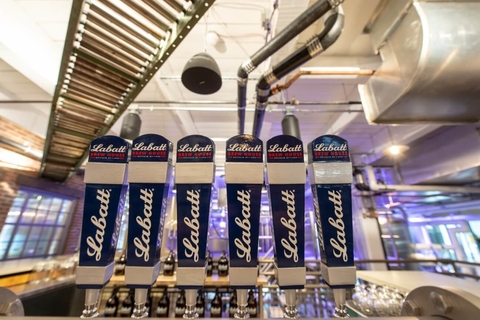
“The sole purpose is for the brewmaster to ‘play in the kitchen,’” we were told during our tour and tasting.
That “kitchen” consists of 10 barrels, four vessels, 11 fermenters and 8 brite tanks with which Brady plays three times per week. The rest of the week, he’s cleaning, packaging and seeking out the feedback of visitors—both good and bad.
Brady’s beers are served straight from the 8 brite tanks and visitor feedback determines Brew House mainstays and specialty offerings, identifies flagships, and roots out brews that prove unpopular. During our visit, we sampled Labatt Blue Citra, along with the first test batches of Labatt Brew House (LBH) Blonde Ale, Amber, Kellerbier, Hefeweizen, Strawberry Gose, Pale Ale, IPA, New England IPA, and Porter.
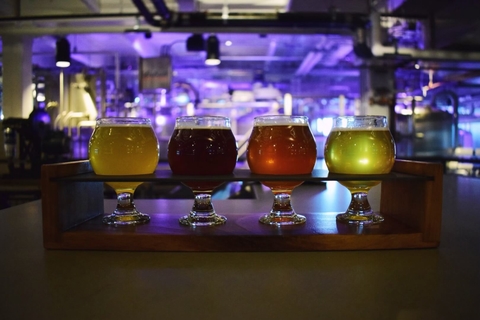
Labatt Blue Citra was in development for about two years, going through 14 revisions and enduring blind consumer testing. During out visit, it was available in four markets on draft. Labatt Blue Citra is intended to appeal to Labatt Blue and Blue Light fans who like IPAs, and consumers seeking a low-ABV, sessionable beer.
Those visiting today would be able to taste the first batches of Porter and Amber that we tried. However, they’d also have the chance to sample LBH Brown Ale 001, Saison 001, and Dry Hopped Sour Ale 001, along with the second batches of Pale Ale, IPA, and New England Style IPA. There’s also what appears to be a collaboration between Brady and Sierra Nevada available: LBH Resilience IPA. Intriguing.
The mission of this innovation brewery is to identify what beer-drinking consumers want and what’s viable in markets across the country. Labatt Blue Citra has found itself in a few markets to obtain even more feedback. But intelligence gathering isn’t the only the mission.
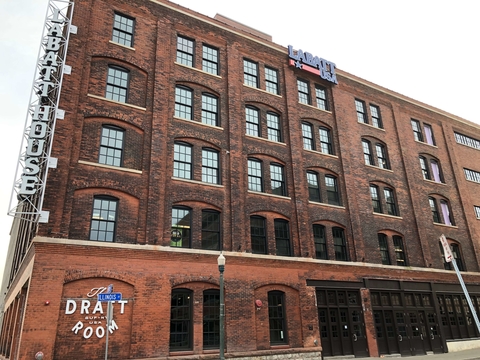
Downtown Buffalo New York has been the subject of development and revitalization efforts. Such projects offer those who take them on great opportunities for long-term success, but they’re also fraught with risk. A brand that nails their attempt proves to the community that they care and are in it with the locals, garnering massive support. Businesses that fail it, however, create negative brand perception and lose resources.
Labatt went all in, choosing a location that offered only two options: great success or hugely visible failure. They rolled the dice on a historic building around 118 years old, meaning they needed to conduct feasibility studies in a space where the ability to make adjustments is limited. Playing it safe was clearly not one of the mission parameters.
To fully grasp why Labatt would make such a visible gamble, one must understand that Buffalo is Labatt’s American home. Labatt Blue is the top-selling Canadian beer in the US, and Buffalo is the largest market in America for Labatt Blue, Labatt Blue Light and other Labatt beers. Recognizing the support it receives from Buffalo, the brewer put its Labatt USA headquarters in the city.
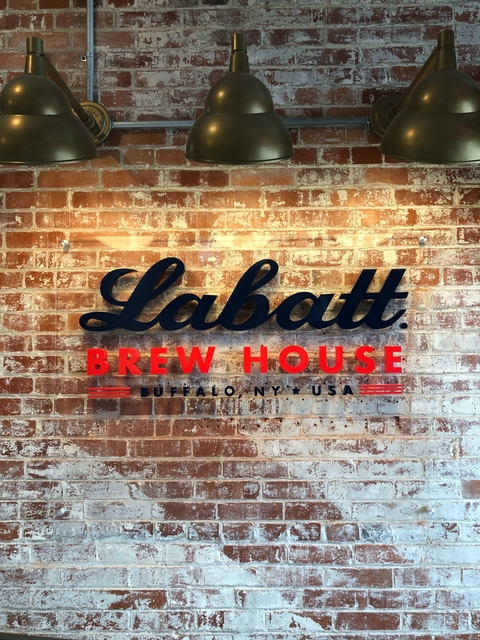
Until November of last year, Labatt USA had its headquarters in Fountain Plaza, located in downtown Buffalo. Interestingly, Fountain Plaza was the result of a downtown Buffalo restoration effort. The historic building that is now home to the Labatt Brew House is now the new home of Labatt USA.
The brewer’s gamble consists of more than an innovation brewery and tasting room. Guests—tourists and locals alike—can turn their sampling visit into a fully realized beer and dining experience via the Draft Room, which is owned and operated by Top Shelf Management, LLC.
Legally, beers poured in the tasting room are prohibited from crossing that area’s threshold into the bar and restaurant space. Overcoming that restriction didn’t prove difficult—tasting room beers are available at the Draft Room bars (outfitted with Perlick stations) and available to those seated at tables, they just aren’t served via the tasting room.
A greater challenge was guest-driven: using the space correctly. When guests enter, they step into a space that smells and feels like brewing history, yet it’s simultaneously new, cool and completely different from any other venue and experience in town. The Draft Room is a 4,000-square-foot space offering communal seating and two bars. The tasting room is right off the Draft Room and Ransom Room (a private space that can be reserved for private dining, meetings, and other events). New visitors need to learn to navigate the space and come to understand that the tasting room is a separate entity from the Draft Room. Management mentioned a plan to collaborate with Labatt Brew House neighbors Buffalo Iron Works for a music festival.
A beer garden doubles the Draft Room’s footprint to 8,000 square feet. It’s outfitted with long tables that inspire communal drinking and eating, a live music stage area, games, and heaters that can stand up to Buffalo winters. When the weather doesn’t call for parkas and heaters, huge roll-up doors are located in the bar area just off the beer garden. Rolling them exposes this bar to the sidewalk and street. Not surprisingly, the Draft Bar does very well during Buffalo Sabres hockey games.
Staff training, of course, is paramount to the success of the Labatt Brew House. Essentially, the concept is two businesses blended into one: a brewery and tasting room attached to a bar and restaurant. When a concept brings with it legal restrictions, a compelling story and purpose, deep history, and a space that requires a certain level of education to use properly, staff shouldn’t be thrown to the wolves. Doing so would detract from the guest experience and be a detriment to employees.
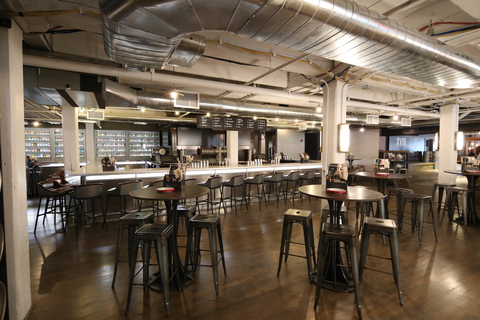
Speaking of the guest experience, food is inventive but true to the area. Buffalo wings are, of course, a menu requirement for any brewpub in Buffalo, as are housemade pretzels, pierogi, and poutine. However, when we were there we saw Canadian bacon strips, empanadas, three salads for the health-conscious and those seeking lighter fare, housemade sandwiches, French bread pizza, a meatball bomber, and a dessert featuring Nutella, banana, sugar and cinnamon.
Guests looking to imbibe have more to choose from than the Labatt portfolio. In fact, the Labatt Brew House always intended to work with craft brewers, not against them. Guests will find beers and ciders from outside of the Labatt portfolio, chosen by the Draft Room staff and available in that section of the venue. When we visited, beers from brewers such as Buffalo’s own Resurgence Brewing Company, Big Ditch Brewing Company and Pressure Drop Brewing; New York’s 12 Gates Brewing Company, 42 North Brewing Company, Beak and Skiff, and Woodcock Brothers Brewing Co.; and Magic Hat were on offer. It’s important to bear in mind that while Labatt is a Big Beer brewer, the Brew House is taking a decidedly craft approach to its mission. Six cocktails, all featuring beer, are also available in the Draft Room.
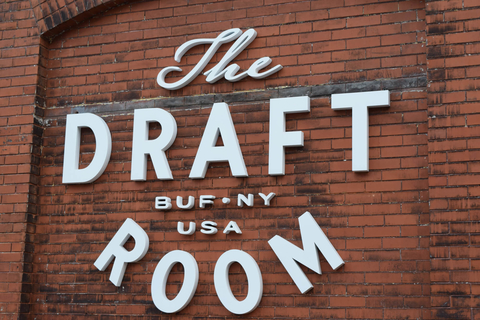
Since we were at the Draft Room, plans to open a wall—within the restrictions of renovating a historic building—to make room for a bakery and coffee shop have been realized. The venue has been navigating the same challenges as any new operation. Management is watching how lunch, happy hour and dinner dayparts perform. Overall, the revenue breakdown is 60/40 alcohol to food.
The Labatt Brew House is a lesson in community and industry outreach, the all-too-important guest experience, experimentation, and quickly adapting to and fulfilling consumer needs. The concept has overtly displayed a desire to partner with businesses that would otherwise be competitors, proven their interest in serving the community, and planning for long-term success. We’ll hoist a few to that.
Want to learn more about topics like this, straight from the best in the industry? Our readers can do exactly that by attending the 2019 Nightclub & Bar Show in Las Vegas this March. Attendees will have in-depth education focused on design, food and beverage programs, operations, marketing, promotions, and more at their fingertips. Register now!
